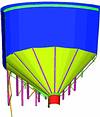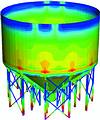Strand7 Release 2.3 launched
1 August 2004

Strand7, the finite element analysis system from Australia, marketed in South Africa by Allyson Lawless, has been dramatically enhanced with the launch of Release 2.3.
The new release offers improved functionality, with new features in all areas of the software designed to appeal to both structural and mechanical engineers. It includes enhancements in areas such as load generation, results enveloping and graphing and also introduces new elements and increased solver capability, among many other new features. While many of the new features have been developed in response to user requests, there are also a number of novel additions such as the string group. Some of the new features include the following:
String group
This is a powerful addition to the Strand7 element library. It is used for modelling a string or cable passing through any number of pulleys or connected points. The string is allowed to freely slide through the pulleys allowing very complex nonlinear situations to be modelled. This new feature allows among other things, modelling of external post-tensioning of concrete beams and the modelling of the erection of deployable structures.

Seismic analysis
Strand7 can now automatically generate quasi-static seismic loads allowing earthquake analysis to be performed in accordance with codes such as the Eurocode EC8 and other national codes. This provides the Strand7 user with yet another method of earthquake analysis in addition to the previously available spectral and time history methods.
Load patch
The load patch is one of the major new features in this release. The load patch is a new type of plate element that has no property attributes and is used solely for transferring loads distributed over an area to beams connected around the perimeter of the load patch. An example of this would be the transfer of wind loads to the side of a building or live loads on a floor slab. The load patch converts the area load into an equivalent line load on the beam. This greatly simplifies the application of loads to a complex array of beams; changing the load on a single plate automatically changes the load on the perimeter beams. A function is included to automatically generate the load patch element from a complex network of interconnected beams, even in 3D.
Non-structural mass
Release 2.3 also sees the introduction of non-structural mass. This allows designers to model live and non-structural dead loads as actual mass rather than applied loads. This mass can be varied across different load cases. Having mass attributes allows their automatic inclusion in all of the dynamic solvers. The non-structural mass can even be optionally scaled for its inclusion in dynamic analysis, in accordance with many national design codes.
More advanced meshing capabilities
Significant improvements have also been incorporated into Strand7's automeshing tools, including the automatic detection and meshing of separate solids defined in IGES files and further enhancements to the geometry cleaning and healing tools.
Projects
Many fascinating projects are being modelled using Strand7 worldwide including several major structures for the Athens and Beijing Olympics and the new Wembley Stadium. Of interest to South African users would be the Goro Nickel Project.
In 2002, Outokumpu, the largest provider of mineral processing technology in Australia, was awarded a contract for nine paste thickeners for the Goro Nickel Project in New Caledonia. These thickeners are 20 m in diameter with a 10 m sidewall above a conical floor section that makes the tanks almost 20 m tall.
All structural aspects of the thickener were modelled using Strand7 including the high torque rake drive unit, the drive shaft, raking mechanism, the bridge structure, and tank and support structure. The drive shaft and raking mechanism model was created in AutoCAD Inventor as a solid model and imported into Strand7 where it was automeshed with plate elements. Beam elements were also used for much of the 3D framework and stiffeners.
This mesh construction method was perfectly suited to the geometry as it had numerous pipe-to-pipe intersections at different angles, which would have been particularly difficult to model manually. Making changes to pipe sizes and orientations was extremely easy and a great deal of time was saved using the automeshing tools.
The tank and support structure was modelled as a complete unit, which allowed for accurate footing loads to be extracted for all load cases.
Strand7 users in South Africa include aeronautical, industrial, consulting, mechanical and mining users.
Others who read this also read these articles
The high-end MCAD and cPDm market segments of the PLM strategy
CIMdata considers the high-end MCAD market to include only those few CAD solution providers that deliver very comprehensive computer-aided design and analysis capabilities that are also tightly integrated with an enterprise-capable cPDm solution from the same supplier[ December 2005 ]
SA's prototype designers awarded
The SABS Design Institute is the driving force behind design promotion in the country through various award schemes, supporting innovation and entrepreneurship[ October 2005 ]
2D to 3D: the path to better products, faster and cheaper
Modern 3D CAD systems allow designers and engineers to edit a few parameters and automatically create the downstream deliverables for unique variants in minutes, instead of days or weeks[ October 2005 ]
ECL in Africa
ECL ensures a worldwide coverage of its client base through local service units which incorporate all the ECL know-how[ August 2005 ]
Catia brings business to South Africa
The fact that the A400M contracts were awarded to local enterprises is a strategic breakthrough for the South African aerospace industry[ August 2005 ]
Strand7 analyses the Beijing Water Cube
The latest Strand7 Release 2.3 has added the capability to take site specific seismic time histories and simply create equivalent spectral curves[ June 2005 ]
Pro/E versus SolidWorks
In summary, SolidWorks' swept surfaces and solids are more limited in their capabilities than Pro/Engineer's[ June 2005 ]
Northern Railway Extension receives green light
Windhoek Consulting Engineers was appointed as consulting engineers for the Northern Railway Extension, responsible for all aspects regarding the design and construction supervision of the total project valued at N$ 1,4 billion[ April 2005 ]
Others who read this also read these news items
Digitising a standard racing engine provides a springboard for future improvements
[ December 2005 ]
Nelson Mandela Metropolitan University leads the way with Catia V5
[ December 2005 ]
Integrated CNC solution for SA tooling industry
[ December 2005 ]
Accelerated design at Donkin Fans
[ December 2005 ]
PGF transforms its vision into reality
[ December 2005 ]
Defy introduces new product range
[ October 2005 ]
New Smarts for legal eagles
[ October 2005, Cadshop ]
Vectorworks scores with architects on ease of use
[ October 2005 ]
Others who read this also read these regulars
Search Site
Subscribe
Previous Issues
Other Technews Publications
Other Technews Buyers Guides
 |  | Copyright c1995-2009 Technews Publishing (Pty) Ltd.. All rights reserved. |